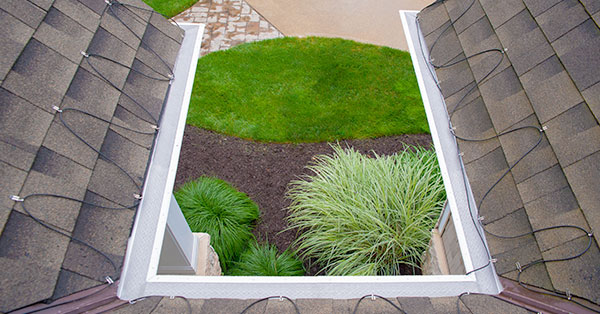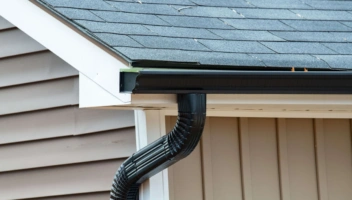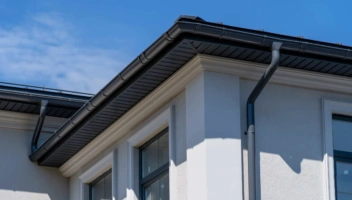Why Foam Gutter Guards Aren’t Worth It

When leaves pile up and gutters start to clog, foam gutter guards may seem like a fast, affordable solution. They’re made from sponge-like foam and sit inside your gutters. Water can pass through them, but they’re supposed to block leaves and other debris. At first glance, they look simple, inexpensive, and easy to install.
We’ve worked with thousands of homeowners, and quick fixes like these often lead to bigger problems over time. Foam guards tend to break down fast, trap moisture, and require more cleaning. We’ll explain the most common problems with foam gutter guards and why a long-term gutter solution is usually the better choice.
In this article:
- What Are Foam Gutter Guards?
- How Do Foam Gutter Guards Work?
- Pros and Cons of Foam Gutter Guards
- Common Problems with Foam Gutter Guards
- Better Alternatives to Foam Gutter Guards
- Frequently Asked Questions
What Are Foam Gutter Guards?
Foam gutter guards are soft inserts made from porous material, usually polyurethane. They sit inside the gutters to help block debris. Their sponge-like texture is supposed to filter larger debris from rainwater. They are easy to trim and lightweight, and marketed as a simple and inexpensive DIY gutter guard option for homeowners.
Why Homeowners Choose Foam Guards
Foam gutter guards catch homeowners’ attention because they’re cheap, easy to find, and seem simple to install. You can walk into just about any hardware store, grab a kit, and have them in your gutters the same day. For homeowners who want to stop leaves from piling up without spending a lot, it sounds like a decent short-term fix.
But in reality, they don’t hold up very well. The foam breaks down when exposed to sunlight, rain, and freezing temperatures. After a season or two, it can start to crumble or get clogged up with dirt and seeds.
At that point, your gutters are worse because now you’ve got soggy foam to deal with too.
How Do Foam Gutter Guards Work?
Foam gutter inserts are designed to sit directly inside your gutters. The idea is that rainwater will flow through the porous material while leaves, pine needles, and other debris remain on top or are blown away. In theory, this setup keeps water moving toward the downspout while blocking the bigger pieces that cause clogs.
Do They Actually Prevent Clogs?
At first, foam gutter guards seem like they’re doing the job. Rainwater runs through, and debris gets held back. But that only lasts so long. Over time, foam tends to act more like a sponge than a filter, and it breaks down fast. It can absorb water, trap fine debris, and start to compress under the weight of leaves or snow.
In colder or wetter climates, this breakdown happens even faster. The foam may shrink, shift, or crumble, leaving gaps that allow debris to pile up inside the gutter. Once that happens, water stops flowing properly, and you’re back to dealing with clogs.
Even worse, you may be dealing with water damage from overflowing gutters.
Pros and Cons of Foam Gutter Guards
Like most quick-fix products, foam gutter guards have pros and cons. Here’s a look at the main advantages and disadvantages, so you can decide if they’re the right fit for your home.
Advantages of Foam Gutter Guards
The biggest benefit of foam gutter guards is that they are very easy to install. You can do it yourself without special tools, a ladder crew, or a professional. Most foam guards are sold in pre-cut strips that can be trimmed to size with a regular kitchen knife or scissors. Once they’re cut, you just press them into the gutter.
Foam gutter guards are also affordable. If you want a low-cost way to protect your gutters, foam guards might seem like a good choice. They appeal to people who are comfortable doing the work themselves. They’re easily available online or in home improvement stores, so it’s easy to pick up a kit when you’re already out running errands.
Disadvantages of Foam Gutter Guards
Foam Gutter Guards Are a Short-Term Solution
There is a reason gutter guard foam is less expensive than other gutter guard products. If you decide to purchase one, you can expect it to last for 1 to 2 years due to unavoidable shrinkage or crumbling. By buying a new foam gutter guard every few years, you will actually end up spending more money. Be cautious of warranties that state that gutter guard foam lasts more than a few years as this claim is almost always false.
Foam Gutter Guards Are Ineffective
Not only does gutter guard foam only last for a few years, but it is also ineffective. It is designed to allow the pores within the sponge-like material to let water pass through to your gutters and down your downspouts. However, a foam gutter guard collects water just like a sponge and oftentimes becomes trapped within the guard. When this occurs, foam gutter guards can support the growth of vegetation because of the dirt and seeds that may be trapped in the foam.
Foam Gutter Guards Are Difficult to Clean
Should you have to clean out your foam gutter guard, you will likely have a tough time. It can be difficult to remove small debris from each and every cell. When you purchase a gutter guard product, you should make sure you don’t have to deal with the inconvenience of cleaning it in the first place.
Common Problems With Foam Gutter Guards
Once foam gutter inserts face rain, wind, and falling leaves, the problems appear quickly. What seems like a quick fix often leads to more clogs, more maintenance, and a need to replace the guards sooner than expected.
Debris Accumulation and Breakdown
Foam is meant to keep leaves out, but it’s not great at blocking smaller debris — pine needles, seeds, and roof grit can easily get caught in the sponge-like surface. Over time, that debris buildup clogs the foam, slows down water flow, and causes gutters to overflow.
As debris collects, the foam may sag or shift out of place. That creates gaps where leaves and dirt slip through, which means your gutters can clog even with guards installed. In a heavy storm, you might find water spilling over the edge instead of draining the way it should.
Overflowing Gutters and Foundation Risks
Overflowing gutters don’t just make a mess; they can also lead to serious foundation issues. If water isn’t draining properly, it can pool around your home and seep into the basement. Choosing the right gutter guard is one important step in learning how to prevent basement flooding and protect your home from costly water damage.
Mold, Mildew, and Pest Issues
One of the biggest problems with foam is how long it holds moisture. Even after a light rain, the material can stay damp for days. That trapped water creates a breeding ground for mold and mildew, especially in warm or humid areas. The result? A foul smell coming from your gutters and an extra mess to clean up.
Damp foam can also attract pests. Insects may nest inside the material, and birds or rodents might try to pull it out while looking for shelter. What was supposed to make gutter maintenance easier can quickly turn into another household chore.

Foam Gutters Can Attract Roof Oil
You may be surprised to find out that a foam gutter guard can attract roof oil. Since it is made out of a petroleum-based product, other petroleum-based products will naturally cling to it. If you invest in a foam gutter guard, you should keep in mind that your roof oil will likely clutch onto it.
Poor Durability and UV Damage
Foam is not built to last. Sun exposure causes it to dry out, crack, and break apart. In the winter, it may shrink or become brittle, creating open gaps in the gutter system. Even the weight of wet leaves can compress the foam and reduce its effectiveness.
Most homeowners find that foam guards only last a season or two before they need to be replaced. That kind of short lifespan means more trips up the ladder and more time spent managing a product that was supposed to reduce hassle, not add to it.
Better Alternatives to Foam Gutter Guards
If you want something built to last, the best gutter guards for your home are a professional system. Micro-mesh guards, like the type LeafFilter uses, block both large and small debris without holding water or falling apart in harsh weather. These systems are built to last and protect your home year after year.
While foam guards may seem like a good short-term fix, they usually lead to more cleaning and more repairs. A long-term solution should do the opposite. The best gutter guards are made to stay in place, perform under pressure, and take one more chore off your list for good.
What to Look for in a Long-Term Gutter Guard
When comparing gutter guard options, start by looking at the materials. Systems made with stainless steel tend to hold up better over time because they resist rust and wear. The best ones use fine mesh that blocks tiny particles without slowing down water flow.
It’s also important to look for a design that seals along the full edge of the gutter. This helps keep out common debris. A good seal keeps water moving through the system and helps reduce the need for frequent cleanouts.
Explore Our Gutter Guard Comparison
Frequently Asked Questions
Are foam gutter guards effective long-term?
No. Foam guards are not effective long-term. They tend to break down after a season or two, especially in areas with heavy rain, snow, or strong sun. They might help for a little while, but they are not built for long-term performance.
Can I install foam guards myself?
Yes. You can install foam guards yourself. They are marketed as a DIY product, and most come in pre-cut strips that you can trim and place by hand. No tools or hardware are required. But easy installation doesn’t always mean lasting results.
Do foam gutter guards need maintenance?
Yes. Foam gutter guards still require maintenance. Foam can trap dirt, leaves, seeds, and small debris over time, which means you’ll likely need to remove and rinse it out regularly. Left unchecked, clogged foam can cause gutters to overflow.
What happens when foam guards break down?
As foam starts to deteriorate, it can shrink, shift out of place, or even crumble inside the gutter. This can block water flow and create new problems, including leaks, water overflow, or water damage to your home’s exterior.
Are there any climates where foam gutter guards work well?
Foam guards may hold up a bit longer in mild, dry climates that don’t have nearby trees. But even in those areas, foam gutter guards still wear down faster than other durable systems and require regular upkeep.


